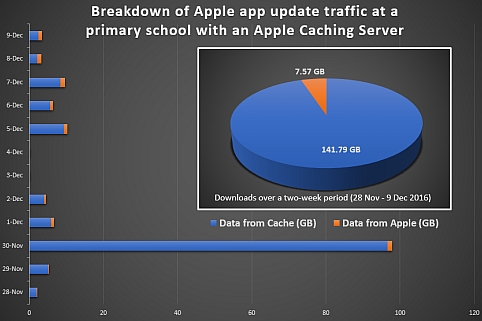The impact of iPad app updates
Many schools with larger school-owned iPad fleets or that offer a BYOD iPad program have discovered the significant impact that app and iOS updates have on the school's internet bandwidth. During term 4, 2017, the department implemented iOS, MacOS and Windows update dowload limits during school hour of up to a maximum of 25% of the school's available bandwidth. This allows for educational access to the internet to be less hindered by automatic system updates to mobile devices. But app updates were not blocked. Let's say 100 students are bringing iPads to school. Each student or their parent has installed pages of apps on the iPads - games, important photo face-swapping apps and everything else that young people must have these days. Maybe there's 50-100 apps on each iPad. Of course, iPad apps are updated regularly and that really important face-swapping app has been updated and by default, every iPad has Automatic App Updates turned on. So automatically, in the background, even while the iPad is sitting in their bags, that app is being updated. It's a 50MB download. But there's 100 students with it, so that's 5GB that has to come through your school's link. And that's just ONE app to update. Without some form of management, large fleets of iPads can quickly swamp the school's Internet link.
What about MacOS app updates?
Like iPad app updates, Apple MacOS app updates are also not blocked during school hours. In 2015 when the department's internet service was being impacted heavily by device updates, Apple Macs represented a small proportion only. But BYOD is being introduced more and more, and Macbooks are appearing in greater numbers. We are finding some schools are significantly being impacted by the automatic MacOS app updates on these laptops and on unmanaged school iMacs. In the first week of November 2016, the top 5 sites in western Sydney alone saw 137GB of their bandwidth consumed by MacOS app updates. So how does a school better manage this invisible bandwidth tax that affects all internet users?
Install an Apple Caching server
An Apple Caching Server (ACS) is a Mac computer that sits inside your school and delivers updates directly to Apple devices in the school without using your internet link for every single update. As soon as one user has requested an update of a specific app or the operating system, the Apple device will identify that a local ACS is present and check for the availability of the required update. If it has never been requested at the school, the update will be retrieved from Apple, with a local copy then stored on the ACS. Any subsequent device that requests the same update will get that update from the ACS automatically, saving the need to go back to Apple for it. So how much bandwidth will it save? The image below explains how an ACS fits into your school's network and the chart on the right is from a mid-sized primary school that recently installed an ACS (click both images for larger views). Over a two week period, the reduction in traffic on the school's internet link is clearly evident.
⚫ How to buy and build a new (2021) Mac Mini M1 as an Apple Caching server
The latest model Apple Mac Mini is very different to the previous model and the build procedure is also very different. It is available now via EdBuy for purchase and easy set up. Please follow this guide carefully.
⚫ How to build a late 2018 Mac Mini as an Apple Caching server
The previous model Apple Mac Mini with INtel processor can also be built, or rebuilt as an Apple Caching Server. Please follow this guide carefully.

